vetclassics joint reviews
Veterinarian formulated for use in dogs and cats over the age of 12 weeks. Our clinically tested formula* provides support for pets in need of advanced joint care. Great for senior pets, those recovering from joint related injuries or surgery, or when the most support is needed.
ArthriEase-GOLD® Powder
Veterinarian formulated for use in dogs and cats over the age of 12 weeks. Our clinically tested formula* provides support for pets in need of advanced joint care. Great for senior pets, those recovering from joint related injuries or surgery, or when the most support is needed.
- Increases Activity*
- MSM
- Green Lipped Mussel
- Glucosamine
- Chondroitin
- Hyaluronic Acid
* In a 70 dog study, dogs on ArthriEase-GOLD had 2.6 greater odds of showing an increase in activity after 25 days, compared to dogs on a placebo. Results may vary. Click here to view the clinical study »
Top Quality Ingredients
Made in the USA
100% Money-back Guarantee
- Product Information
- Active Ingredients
- Inactive Ingredients
- Directions for Use
Veterinarian formulated for use in dogs and cats over the age of 12 weeks. Our clinically tested formula* provides support for pets in need of advanced joint care. Great for senior pets, those recovering from joint related injuries or surgery, or when the most support is needed.
- Increases Activity*
- MSM
- Green Lipped Mussel
- Glucosamine
- Chondroitin
- Hyaluronic Acid
* In a 70 dog study, dogs on ArthriEase-GOLD had 2.6 greater odds of showing an increase in activity after 25 days, compared to dogs on a placebo. Results may vary. Click here to view the clinical study »
Cautions: If animal’s condition worsens or does not improve, stop product administration and consult your veterinarian. Safe use in pregnant animals or animals intended for breeding has not been proven.
Warnings: Not for human consumption. Keep out of the reach of children and animals. In case of accidental overdose, contact a health professional immediately.
Active Ingredients Per Heaping ½ Teaspoon:
- Glucosamine HCl (Shellfish Source) – 500 mg
- Methylsulfonylmethane (MSM) – 500 mg
- Chondroitin Sulfate (Porcine Source) – 200 mg
- Green Lipped Mussel (Perna canaliculus) – 200 mg
- Boswellia serrata – 90 mg
- Yucca schidigera – 90 mg
- Calcium Ascorbate (Vitamin C) – 60 mg
- Zinc Sulfate – 7 mg
- Hyaluronic Acid – 5 mg
- Vitamin E (DL-alpha Tocopheryl Acetate) – 60 IU
- alpha-Amylase (Aspergillus oryzae) – 290 SKBU
- Lipase (Aspergillus niger) – 27 LU
- Cellulase (Trichoderma longibrachiatum) – 10 CMCU
- Protease (Papaya) – 2763 PU
- Probiotic (Bacillus coagulans) – 13 Million CFU
Fructooligosaccharides, Natural Flavoring, Silicon Dioxide.
Directions For Use: (Maintenance)
- Up to 10 lbs. – ¼ teaspoon Daily
- 11 to 39 lbs. – ½ teaspoon Daily
- 40 to 79 lbs. – 1 teaspoon Daily
- 80 lbs. and over – 1½ teaspoons Daily
Double the daily amount for the first 3 weeks. Daily amount can be divided between AM and PM. Use only as directed by your veterinarian. Responses to supplements may vary by animal.
We’ll list all the best products within a category and offer a product comparison table so you can make a great purchase that meets your goals and your budget.
Our Best Choice: VetriScience Laboratories GlycoFlex PLUS, Clinically Proven Hip and Joint Supplement for Dogs with Chondroitin, Perna, MSM and Glucosamine. 120 Bite Size Chews now in 3 Zesty Flavors
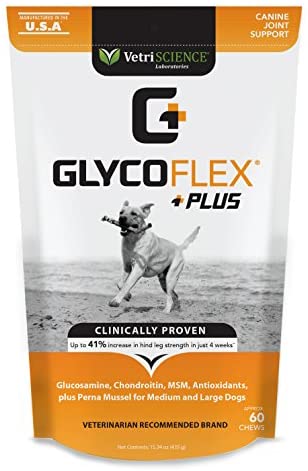
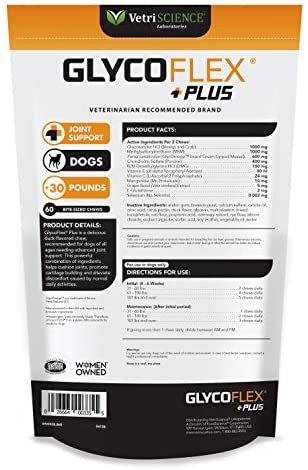
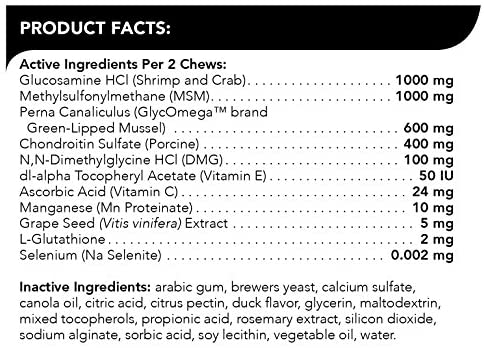
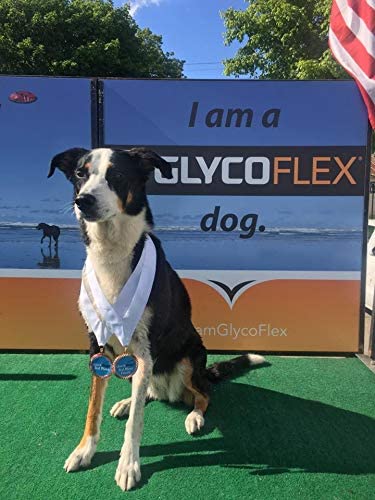
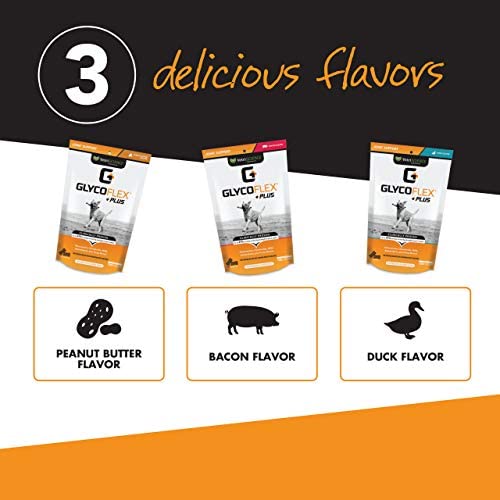
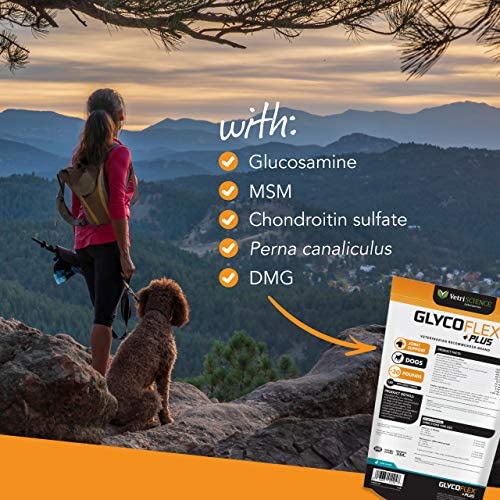
Our rating:  (4.7 / 5)
(4.7 / 5)
Is Discontinued By Manufacturer:No
Product or service Dimensions:6.5 x 3 x 11.5 inches 1 Lbs
Product product number:090092E.060
Day 1st Available:July 1, 2015
Manufacturer:Vetri-Science Laboratories
ASIN:B0116E4BUS
Place of Origin:USA
If you want to buy the best for your cat, regardless of price, VetClassics ArthriEase-GOLD Hip & Joint Support Powder Dog & Cat Supplement is the best supplement you can get. This supplement is specifically designed for pets that have severe joint problems, such as arthritis.
1. Nutramax Cosequin Capsules Joint Health – Best Overall
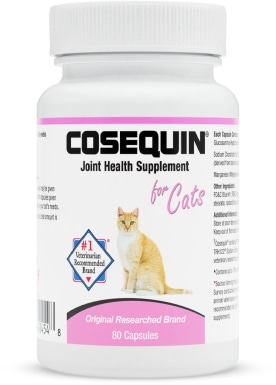
| Life Stage | All – Adult, senior, or kitten |
| Product Form | Capsules |
| Active Ingredients | Glucosamine hydrochloride, sodium chondroitin sulfate, manganese |
The best overall joint supplement for cats is the Nutramax Cosequin Capsules Joint Health. Available at Chewy.com, these capsules are convenient, reasonably priced, and super effective. As a result, these supplements can help cats of any age feel comfortable playing and jumping.
Many cat owners and cats have tried Nutramax Cosequin Capsules Joint Health with great results. People report positive experiences in terms of capsule flavor and effectiveness. Many cat owners note that they have been using this supplement for decades, proving how effective it is over the long run.
Although the supplement is a bit pricier than some others, the price is not outrageous, especially considering its effectiveness. If you are looking for the best joint supplement for your cat, Nutramax Cosequin Capsules Joint Health is right for you.
- Highly effective
- Trusted by many cat owners and vets
- Nice flavor
- Easy to get ahold of
- Not the cheapest option
2. NaturVet VitaPet Senior Glucosamine Cat Soft Chews – Best Value
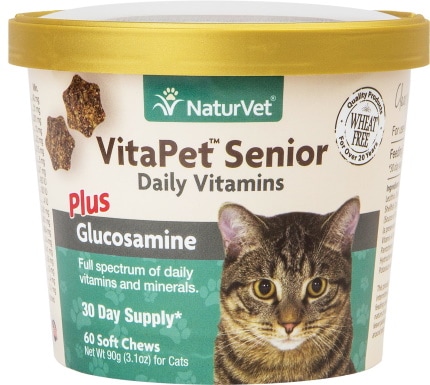
| Life Stage | Senior |
| Product Form | Soft chew |
| Active Ingredients | Calcium, phosphorus, iron, potassium, copper, zinc, manganese, iodine, vit A, vit D3, vit E, riboflavin, thiamine, pantothenic acid, pyridoxine, niacin, glucosamine, inositol, vit C, cobalt |
The best joint supplement for cats for the money is the NaturVet VitaPet Senior Glucosamine Cat Soft Chews. Although specifically designed for seniors, this supplement can help your cat have loose and comfortable joints without spending a fortune. Cat owners on a budget will appreciate this supplement as a result.
This supplement includes full spectrum vitamins that are safe for all cats over 12 weeks, but it is specifically made with senior cats in mind. The additional glucosamine is what provides the cat with additional joint support. Formulated by veterinarians and manufactured in the US, you can trust this supplement to keep your cat active and healthy as it ages.
If your senior cat is having a difficult time chewing because of weakening teeth, the supplement is still a good choice. Because it is a soft and tasty chew, most cats have no issues chewing the supplement.
- Highly affordable
- Safe for cats of all ages
- Includes full spectrum vitamins
- Extra glucosamine for joint support
- Specifically for aging cats
- Includes a lot of inactive ingredients
3. VetClassics ArthriEase-GOLD Hip & Joint Support Powder Dog & Cat Supplement – Premium Choice
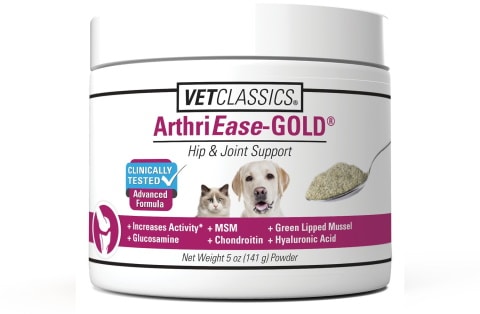
| Life Stage | Adult, senior |
| Product Form | Powder |
| Active Ingredients | Glucosamine, methylsulfonyl-methane, chondroitin sulfate, green lipid mussel, Boswellia serrata, yucca schidigera, vit C, zinc sulfate, hyaluronic acid, vit E |
If you want to buy the best for your cat, regardless of price, VetClassics ArthriEase-GOLD Hip & Joint Support Powder Dog & Cat Supplement is the best supplement you can get. This supplement is specifically designed for pets that have severe joint problems, such as arthritis.
Although highly expensive, this powder supplement has been clinically tested for effectiveness, making it 2.6 times better than other supplements in clinical tests. The reason for its effectiveness is because the ingredients help to support cartilage, connective tissues, and overall joint movement, but it also helps to alleviate aches.
Because this is our premium choice, the VetClassics ArthriEase-GOLD Hip & Joint Support Powder Dog & Cat Supplement is very expensive, but it comes with a 100% satisfaction guarantee to help make the purchase worth it despite the high price tag.
- 6 times more effective in clinical trials
- Ideal for cats with severe joint pains
- Easy to sprinkle over food
- 100% satisfaction guarantee
- Highly expensive
4. Pet Naturals Hip + Joint Cat Chews – Best for Kittens
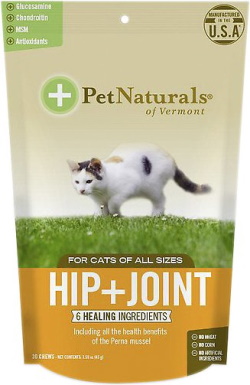
| Life Stage | All – Adult, senior, or kitten |
| Product Form | Soft chew |
| Active Ingredients | Glucosamine, methylsulfonyl-methane, green lipid mussel, chondroitin sulfate, ascorbic acid, manganese |
Starting your cat on a joint supplement from a young age is a great way to ensure that your cat grows healthy and strong. The best joint supplement for kittens is the Pet Naturals Hip + Joint Cat Chews. These chews are soft, making them easy and tasty for the kitten to eat. Plus, the ingredients are designed for all life stages, not just senior cats.
Pricewise, these soft chews are super affordable. The low price will make buying these chews for your kitten as it grows much more palatable since it doesn’t cost a fortune. At the same time, the ingredients are effective so that this supplement does its job too. As your kitten grows, you can continue giving the supplement to your cat since it is suitable for adult and senior cats too.
Because this supplement is designed for cats of all life stages, it isn’t the most effective for arthritis-riddled cats. If your cat has serious joint issues, you probably will want something more effective.
Do you get stressed out thinking about shopping for a great Vet Classics Stop Stool Eating Reviews? Do doubts keep creeping into your mind? We understand, because we’ve already gone through the whole process of researching Vet Classics Stop Stool Eating Reviews, which is why we have assembled a comprehensive list of the greatest Vet Classics Stop Stool Eating Reviews available in the current market. We’ve also come up with a list of questions that you probably have yourself.
Do you get stressed out thinking about shopping for a great Vet Classics Stop Stool Eating Reviews? Do doubts keep creeping into your mind? We understand, because we’ve already gone through the whole process of researching Vet Classics Stop Stool Eating Reviews, which is why we have assembled a comprehensive list of the greatest Vet Classics Stop Stool Eating Reviews available in the current market. We’ve also come up with a list of questions that you probably have yourself.
Romance University has done the best we can with our thoughts and recommendations, but it’s still crucial that you do thorough research on your own for Vet Classics Stop Stool Eating Reviews that you consider buying. Your questions might include the following:
- Is it worth buying an Vet Classics Stop Stool Eating Reviews?
- What benefits are there with buying an Vet Classics Stop Stool Eating Reviews?
- What factors deserve consideration when shopping for an effective Vet Classics Stop Stool Eating Reviews ?
- Why is it crucial to invest in any Vet Classics Stop Stool Eating Reviews, much less the best one?
- Which Vet Classics Stop Stool Eating Reviews are good in the current market?
- Where can you find information like this about Vet Classics Stop Stool Eating Reviews ?
We’re convinced that you likely have far more questions than just these regarding Vet Classics Stop Stool Eating Reviews, and the only real way to satisfy your need for knowledge is to get information from as many reputable online sources as you possibly can.
Potential sources can include buying guides for Vet Classics Stop Stool Eating Reviews, rating websites, word-of-mouth testimonials, online forums, and product reviews. Thorough and mindful research is crucial to making sure you get your hands on the best-possible Vet Classics Stop Stool Eating Reviews. Make sure that you are only using trustworthy and credible websites and sources.
Romance University provides an Vet Classics Stop Stool Eating Reviews buying guide, and the information is totally objective and authentic. We employ both AI and big data in proofreading the collected information. How did we create this buying guide? We did it using a custom-created selection of algorithms that lets us manifest a top-10 list of the best available Vet Classics Stop Stool Eating Reviews currently available on the market.
This technology we use to assemble our list depends on a variety of factors, including but not limited to the following:
- Brand Value: Every brand of Vet Classics Stop Stool Eating Reviews has a value all its own. Most brands offer some sort of unique selling proposition that’s supposed to bring something different to the table than their competitors.
- Features: What bells and whistles matter for an Vet Classics Stop Stool Eating Reviews?
- Specifications: How powerful they are can be measured.
- Product Value: This simply is how much bang for the buck you get from your Vet Classics Stop Stool Eating Reviews.
- Customer Ratings: Number ratings grade Vet Classics Stop Stool Eating Reviews objectively.
- Customer Reviews: Closely related to ratings, these paragraphs give you first-hand and detailed information from real-world users about their Vet Classics Stop Stool Eating Reviews.
- Product Quality: You don’t always get what you pay for with an Vet Classics Stop Stool Eating Reviews, sometimes less, and sometimes more.
- Product Reliability: How sturdy and durable an Vet Classics Stop Stool Eating Reviews is should be an indication of how long it will work out for you.
Romance University always remembers that maintaining Vet Classics Stop Stool Eating Reviews information to stay current is a top priority, which is why we are constantly updating our websites. Learn more about us using online sources.
If you think that anything we present here regarding Vet Classics Stop Stool Eating Reviews is irrelevant, incorrect, misleading, or erroneous, then please let us know promptly! We’re here for you all the time. Contact us here. Or You can read more about us to see our vision.
A 5-year-old spayed female Bernese mountain dog, with a chief complaint of vomiting and melena ingested approximately 200 nutritional joint supplement tablets. Despite aggressive therapy, the patient developed a coagulopathy, pancreatitis, peritonitis, acute kidney injury, and was euthanized. Postmortem examination revealed myocardial necrosis, pneumonia, centrilobular hemorrhage and necrosis of the liver, vasculitis, and acute tubular necrosis.
Case description
A 5-year-old, spayed female, Bernese mountain dog ingested approximately 200 joint supplement chews (Joint MAX Triple Strength; Pet Health Solutions, Union City, California, USA). The estimated doses of glucosamine and chondroitin sulfate ingested were 2173 mg/kg body weight (BW) and 217 mg/kg BW, respectively. The patient was presented to the veterinarian approximately 10 h after ingestion with a chief complaint of vomiting, inappetence, and lethargy. On examination, the patient was quiet but responsive, cardiothoracic auscultation was normal, and abdominal palpation was unremarkable. Melena was present on rectal examination. Body condition score was 6/9. Blood tests showed markedly elevated hepatocellular enzymes and moderately elevated bilirubin levels.
Upon presentation to the critical care service, approximately 16 h after ingestion, the patient’s physical examination findings were unchanged. Diagnostic tests included a complete blood (cell) count (CBC), serum biochemistry, coagulation parameters, abdominal radiographs, and urinalysis. The CBC abnormalities included moderate hemoconcentration at 59% [reference range (RR): 37% to 55%], mild neutrophilia at 13.88 × 10 3 /μL (RR: 2.0 to 12.0 × 10 3 /μL), mild basophilia at 0.10 × 10 3 /μL (RR: 0.00 to 0.10 × 10 3 /μL), and a decreased mean corpuscular hemoglobin concentration at 293 g/L (RR: 300 to 375 g/L). Serum chemistry abnormalities included moderately elevated alkaline phosphatase (ALKP = 509 U/L; RR: 23 to 212 U/L), mildly elevated total bilirubin (tBil) at 30.8 μmol/L (RR: 0.0 to 15.4 μmol/L), and mildly elevated lipase at 1997 U/L (RR: 200 to 1800 U/L). A blood sample sent to a reference laboratory showed the alanine aminotransferase (ALT) markedly elevated at 14 950 U/L (RR: 12 to 118 U/L), prolonged prothrombin time (PT) of 18.5 s (RR: 5.5 to 12 s), and a normal activated partial thromboplastin time (aPTT) of 22.5 s (RR: 10 to 25 s). Urinalysis revealed a urine specific gravity (USG) of 1.033, a pH of 7.5, proteinuria (3+), bilirubinuria (3+), and hematuria (2+). A sediment was not evaluated. The most significant abdominal radiographic finding was generalized loss of serosal detail. An abdominal ultrasound was recommended but declined.
A consulting veterinarian at the ASPCA Animal Poison Control Center (APCC) was contacted and indicated several cases of liver failure had been associated with joint supplement overdosage in recent years. The most common side effects of acute joint supplement toxicity included moderate to severe gastroenteritis, elevated liver enzymes, and prolonged clotting times. Treatment recommendations made by the APCC included intravenous fluid therapy with vitamin B complex supplementation, anti-emetics, abdominal pain control, N-acetylcysteine or S-adenosylmethionine (SAM-E) if the patient was not vomiting.
The dog was treated with intravenous fluids containing vitamin B complex (Vitamin B complex; Phoenix Pharmaceutical, St. Joseph, Missouri, USA), 2 mL/L, and a crystalloid (Normosol R; Hospira, Lake Forest, Illinois, USA) bolus of 65 mL/kg body weight (BW) followed by a rate of 5.4 mL/kg BW per hour. The following medications were administered: S-adenosylmethionine with silybin (Denamarin; Nutramax Laboratories, Lancaster, South Carolina, USA), 20 mg/kg BW, PO, q24h, famotidine (Famotidine; APP Pharmaceuticals, Shaumburg, Illinois, USA), 1 mg/kg BW, IV, q24h, maropitant (Maropitant citrate; Zoetis, New York, New York, USA), 1 mg/kg BW, SC, q24h, vitamin K1 (Vitamin K1; Phoenix Pharmaceutical), 3 mg/kg BW, SC, q12h, and ampicillin sodium/sublactam sodium (Ampicillin sodium/sublactam sodium; AuroMedics Pharma, Dayton, New Jersey, USA), 22 mg/kg BW, IV, q8h.
The following morning, the patient had peripheral edema, icteric mucous membranes, abdominal pain, and prominently enlarged popliteal lymph nodes. The patient’s heart rate remained elevated at 160 beats/min, and occasional runs of ventricular premature contractions were noted on continuous electrocardiography. The patient was transitioned to oral famotidine (Famotidine; TEVA Pharmaceuticals, Sellerville, Pennsylvania, USA), 1 mg/kg BW, PO, q24h, vitamin K1 (Vitamin K; Bimeda, Le Sueur, Minnesota, USA), 2.3 mg/kg BW, PO, q12h, and amoxicillin with clavulanic acid (Clavamox; Zoetis), 18.75 mg/kg BW, PO, q12h. Treatment with S-adenosylmethionine with silybin, maropitant, and crystalloids was continued as previously described. A coagulation panel submitted to a reference laboratory showed prolongation of PT (39 s) and APTT (41 s). The serum biochemical profile revealed mild hypoproteinemia (48 g/L; RR: 50 to 74 g/L), mild hypoalbuminemia (22 g/L; RR: 27 to 44 g/L), markedly elevated aspartate aminotransferase (AST) (4389 U/L; RR: 15 to 66 U/L), markedly elevated ALT (14 343 U/L), moderately elevated ALKP (345 U/L), moderately elevated gamma glutamyltransferase (GGT) (19 U/L; RR: 1 to 12 U/L), moderately elevated tBil (58.1 μmol/L; RR: 1.7 to 5.1 μmol/L), and mild hypocalcemia (2.17 mmol/L; RR: 2.23 to 2.85 mmol/L).
On day 3 of hospitalization, the patient tolerated oral medications but remained lethargic and icteric. The serum chemistry showed progressive worsening of liver values including mild hypoalbuminemia (22 g/L), markedly elevated but improved AST (2580 U/L), moderately elevated ALP (431 U/L), markedly elevated but improved ALT levels (12 848 U/L), severe elevation in GTP (22 U/L); markedly elevated tBil (94.1 μmol/L; RR: 1.7 to 5.1 μmol/L) and mild hypocalcemia (2.1 mmol/L).
On day 4 of hospitalization, the patient developed abdominal distention with a palpable fluid wave. Serum chemistry showed persistent abnormalities in liver values, with worsening hyperbilirubinemia (119.7 μmol/L), and moderately elevated creatinine phosphokinase (1189 U/L; RR: 59 to 895 U/L).
By day 5 of hospitalization, the patient remained anorexic and depressed and failed to show any clinical improvement. The most significant changes on the serum chemistry included a markedly elevated total bilirubin (183 μmol/L), moderate azotemia [blood urea nitrogen (BUN), 23.2 mmol/L, serum creatinine 221 mmol/L], mild hyponatremia (serum sodium 137 mmol/L; RR: 139 to 154 mmol/L), mild hyperkalemia (serum potassium 5.8 mmol/L; RR: 3.6 to 5.5 mmol/L), and highly elevated creatinine phosphokinase (2080 U/L; RR: 59 to 895 U/L). An abdominal ultrasound showed a moderate amount of anechoic fluid, hyperechoic liver, loss of corticomedullary distinction in both kidneys, and markedly hyperechoic omentum and mesentery. An abdominocentesis was performed and approximately 2 L of clear fluid were removed from the abdomen. The abdominal fluid was not submitted for analysis but, based on appearance, was suspected to be a transudate or modified transudate. Due to lack of response to therapy, worsening condition and poor prognosis, the owner elected euthanasia.
The patient’s body was submitted for necropsy. Grossly, the integument and subcutaneous fat were yellow and edematous. The peritoneal cavity contained 2 L of serosanguinous fluid. Multifocal to coalescing petechial and ecchymotic hemorrhages were present throughout the diaphragm and epicardium. The right auricle and atrioventricular valves were thickened. The tracheobronchial lymph nodes were enlarged. Two firm, circumscribed masses were observed in the right middle lung lobe. The liver was diffusely enlarged, friable, and had a prominent reticular pattern. Macroscopic and microscopic areas of hemorrhage were present in the pancreas and the cortex of the kidneys. The final histologic diagnosis was diffuse hemorrhagic myocardial necrosis characterized by necrotizing vasculitis, pancreatitis, marked hepatic centrilobular necrosis with mild chronic periportal fibrosis, membranoproliferative glomerulonephropathy, acute tubular necrosis, histiocytic to lymphoplasmacytic pneumonia and a malignant pulmonary fibrous histocytoma of the right middle lung lobe. There was no evidence of metastasis.
A postmortem toxicology panel performed on a wet-weight basis showed elevated levels of iron and manganese in the liver. The liver had mildly elevated iron values at 514 ppm (RR: 100 to 500 ppm) and the manganese levels were above the reference range at 13.4 ppm (RR: 1.00 to 5.00 ppm). The arsenic, copper, cadmium, lead, thallium, and zinc levels in the kidney and liver were not elevated.